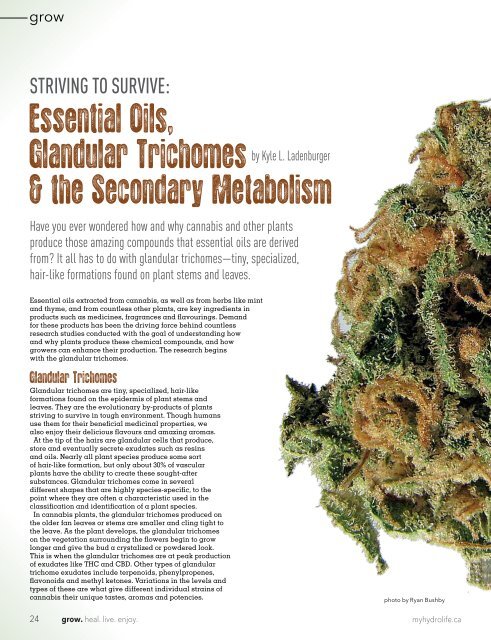Hydrolife Magazine June/July 2016 (CAN Edition)
In the new June/July edition of Hydrolife we explore how, rather than being a gateway, cannabis is actually reducing reliance on opiates used commonly for pain treatment. We also take a look at the many methods that can be employed for using cannabis for pain management. Our Ask a Nurse column provides helpful tips for those considering cannabis, and our writers have gone to great efforts to explain how various strains have different effects and qualities. So in this edition of Hydrolife we invite you to Grow, Live and Heal, but most of all, Enjoy!
In the new June/July edition of Hydrolife we explore how, rather than being a gateway, cannabis is actually reducing reliance on opiates used commonly for pain treatment. We also take a look at the many methods that can be employed for using cannabis for pain management. Our Ask a Nurse column provides helpful tips for those considering cannabis, and our writers have gone to great efforts to explain how various strains have different effects and qualities. So in this edition of Hydrolife we invite you to Grow, Live and Heal, but most of all, Enjoy!
Create successful ePaper yourself
Turn your PDF publications into a flip-book with our unique Google optimized e-Paper software.
grow<br />
STRIVING TO SURVIVE:<br />
Essential Oils,<br />
Glandular Trichomes<br />
by Kyle L. Ladenburger<br />
& the Secondary Metabolism<br />
Have you ever wondered how and why cannabis and other plants<br />
produce those amazing compounds that essential oils are derived<br />
from? It all has to do with glandular trichomes—tiny, specialized,<br />
hair-like formations found on plant stems and leaves.<br />
Essential oils extracted from cannabis, as well as from herbs like mint<br />
and thyme, and from countless other plants, are key ingredients in<br />
products such as medicines, fragrances and flavourings. Demand<br />
for these products has been the driving force behind countless<br />
research studies conducted with the goal of understanding how<br />
and why plants produce these chemical compounds, and how<br />
growers can enhance their production. The research begins<br />
with the glandular trichomes.<br />
Glandular Trichomes<br />
Glandular trichomes are tiny, specialized, hair-like<br />
formations found on the epidermis of plant stems and<br />
leaves. They are the evolutionary by-products of plants<br />
striving to survive in tough environment. Though humans<br />
use them for their beneficial medicinal properties, we<br />
also enjoy their delicious flavours and amazing aromas.<br />
At the tip of the hairs are glandular cells that produce,<br />
store and eventually secrete exudates such as resins<br />
and oils. Nearly all plant species produce some sort<br />
of hair-like formation, but only about 30% of vascular<br />
plants have the ability to create these sought-after<br />
substances. Glandular trichomes come in several<br />
different shapes that are highly species-specific, to the<br />
point where they are often a characteristic used in the<br />
classification and identification of a plant species.<br />
In cannabis plants, the glandular trichomes produced on<br />
the older fan leaves or stems are smaller and cling tight to<br />
the leave. As the plant develops, the glandular trichomes<br />
on the vegetation surrounding the flowers begin to grow<br />
longer and give the bud a crystalized or powdered look.<br />
This is when the glandular trichomes are at peak production<br />
of exudates like THC and CBD. Other types of glandular<br />
trichome exudates include terpenoids, phenylpropenes,<br />
flavonoids and methyl ketones. Variations in the levels and<br />
types of these are what give different individual strains of<br />
cannabis their unique tastes, aromas and potencies.<br />
photo by Ryan Bushby<br />
24<br />
grow. heal. live. enjoy.<br />
myhydrolife.ca




![Hydrolife Magazine December 2017/January 2018 [CANADIAN EDITION]](https://img.yumpu.com/59790088/1/190x247/hydrolife-magazine-december-2017-january-2018-canadian-edition.jpg?quality=85)
![Hydrolife Magazine December 2017/January 2018 [USA EDITION]](https://img.yumpu.com/59790042/1/190x247/hydrolife-magazine-december-2017-january-2018-usa-edition.jpg?quality=85)
![Hydrolife Magazine October/November 2017 [Canada Edition]](https://img.yumpu.com/59493562/1/190x247/hydrolife-magazine-october-november-2017-canada-edition.jpg?quality=85)
![Hydrolife Magazine October/November 2017 [USA Edition]](https://img.yumpu.com/59493548/1/190x247/hydrolife-magazine-october-november-2017-usa-edition.jpg?quality=85)
![Hydrolife Magazine August/September 2017 [USA Edition]](https://img.yumpu.com/59236656/1/190x247/hydrolife-magazine-august-september-2017-usa-edition.jpg?quality=85)









